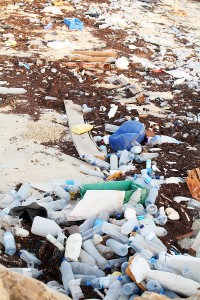

Government scientists on a recent survey of southeast Alaska beaches found a number of large black buoys, the likes of which they hadn’t seen in the region on a 2008 trip. But they cannot say if the buoys are related to last year’s devastating tsunami in Japan or just routine ocean debris.
A five-member team for the National Oceanic and Atmospheric Administration recently completed a 10-day trip beginning in Ketchikan and ending in Juneau, covering about 48 miles of shoreline across 550 miles of outside coast. It was billed as the first NOAA survey in Alaska specifically for tsunami debris.
NOAA typically does marine debris surveys every 5 to 10 years. The last was in 2008.
Jacek Maselko, a NOAA biologist and chief scientist on the survey, said compared to 2008, the southeast Alaska sites visited didn’t have a greater density of marine debris, though the large, black, oval buoys stood out. A NOAA spokeswoman said 27 of the buoys were found during the trip.
There have been several high-profile cases of debris reaching U.S. shores that have been tied to the tsunami with objects traced back to their owners. But items from Asia, like buoys and litter, wash up on the U.S. Pacific coast all the time, NOAA said, making it difficult to distinguish the source of the debris.
Some groups that routinely clean ocean debris from Alaska beaches – particularly in the Gulf of Alaska – have reported a difference in the volume and type of debris they’re seeing, which they attribute to the arrival of debris from the disaster. NOAA says significant changes in the type and amount of debris on a shoreline are an indicator that it is from the tsunami.
Part of what Maselko is trying to do is document what’s out there and compare that to prior years; NOAA marine surveys for some Alaska beaches go back to the early 1970s. He also plans to identify monitoring beaches that can be revisited later to assess any changes.
He is planning to survey sites further north and west later this summer, including the gulf region.
Maselko said that once he obtains the data, he will be able to make a comparison that should allow him to say whether there is more or less debris than in 2008.
“I’m trying to just kind of keep an open mind,” he said.